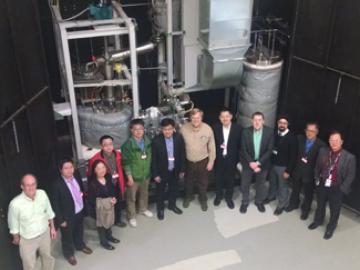Filter News
Area of Research
- (-) Materials (42)
- (-) Nuclear Science and Technology (6)
- Advanced Manufacturing (4)
- Biological Systems (4)
- Building Technologies (2)
- Chemistry and Physics at Interfaces (3)
- Clean Energy (46)
- Energy Frontier Research Centers (4)
- Fossil Energy (1)
- Functional Materials for Energy (3)
- Geographic Information Science and Technology (1)
- Isotope Development and Production (1)
- Materials Synthesis from Atoms to Systems (2)
- Materials Under Extremes (3)
- Neutron Science (7)
- Quantum Condensed Matter (1)
- Reactor Technology (1)
- Supercomputing (11)
- Transportation Systems (3)
News Type
Media Contacts

It took marine sponges millions of years to perfect their spike-like structures, but research mimicking these formations may soon alter how industrial coatings and 3-D printed objects are produced.


Less than 1 percent of Earth’s water is drinkable. Removing salt and other minerals from our biggest available source of water—seawater—may help satisfy a growing global population thirsty for fresh water for drinking, farming, transportation, heating, cooling and industry. But desalination is an energy-intensive process, which concerns those wanting to expand its application.

Representatives from the Oak Ridge National Laboratory (ORNL) and the Shanghai Institute of Applied Physics (SINAP) are meeting at ORNL this week as part of an agreement between the two institutions to work together on the advancement

Graphene, a strong, lightweight carbon honeycombed structure that’s only one atom thick, holds great promise for energy research and development. Recently scientists with the Fluid Interface Reactions, Structures, and Transport (FIRST) Energy Frontier Research Center (EFRC), led by the US Department of Energy’s Oak Ridge National Laboratory, revealed graphene can serve as a proton-selective permeable membrane, providing a new basis for streamlined and more efficient energy technologies such as improved fuel cells.






